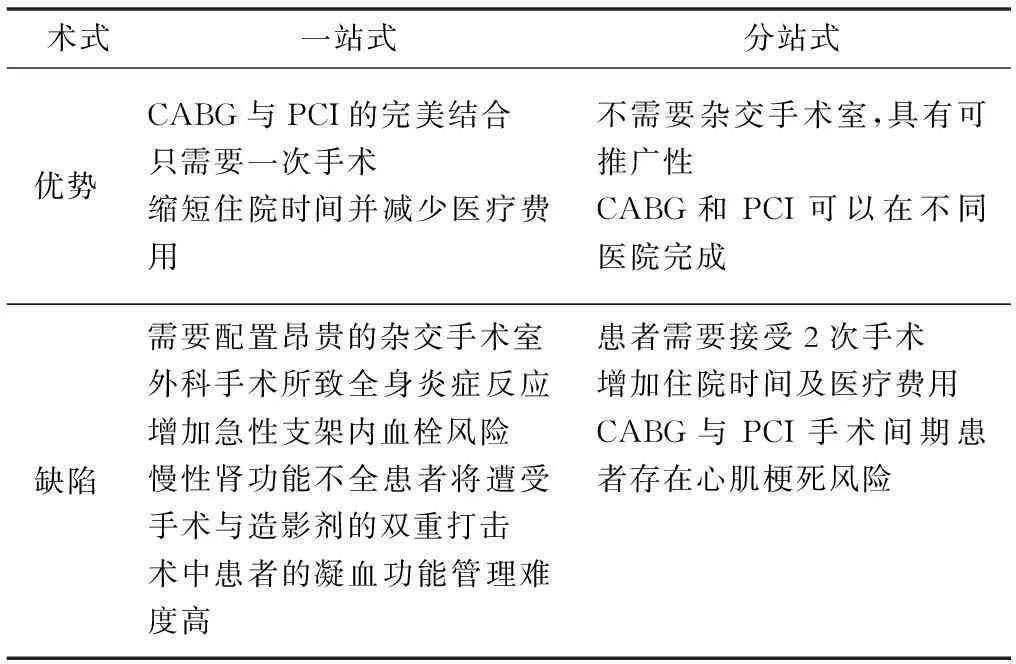前程似锦,任重道远——冠状动脉杂交血运重建的现在与未来
2016-03-04200025上海交通大学附属瑞金医院心脏外科
200025,上海交通大学附属瑞金医院心脏外科

前程似锦,任重道远
——冠状动脉杂交血运重建的现在与未来

200025,上海交通大学附属瑞金医院心脏外科
赵强
《国际心血管病杂志》主编,上海交通大学附属瑞金医院副院长、心脏外科主任、中华医学会胸心血管外科委员、中国医师协会心血管外科常委、中国医师协会心血管外科冠心病主委、上海市医学会心血管外科副主委、美国胸外科医师协会(STS)委员、国际微创心血管外科(ISMIC)委员。
冠状动脉血运重建技术已经历了经半个世纪的发展。冠状动脉外科技术从上世纪五十年代的大切口、体外循环冠状动脉旁路移植术(CABG),向小切口、非体外循环方向发展;九十年代开展小切口微创冠状动脉旁路移植术(MIDCAB)和机器人辅助全腔镜冠状动脉旁路移植术(TECAB)。经皮冠状动脉介入技术(PCI)从上世纪八十年代单纯球囊成形术(PTCA),发展到金属裸支架(BMS)、药物涂层支架(DES)和可吸收支架。1996年Angelini等首次提出了一个崭新的概念:冠状动脉杂交血运重建(HCR)——将CABG和PCI相结合,取二种技术各自的优点,为冠心病患者提供最优化治疗。
1何谓HCR
目前对于如何治疗冠状动脉多支病变(MCAD)仍存在不少争议。毫无疑问CABG至今仍然是治疗MCAD的有效手段,尤其对于重度病变(Syntax评分>32)、左主干病变以及糖尿病患者,其疗效显著优于PCI及药物治疗。长期随访证明,左侧乳内动脉(LIMA)10年通畅率超过90%。对于左前降支(LAD)单支病变,LIMA-LAD远期生存明显优于支架,被誉为冠心病患者的“生命桥”。MIDCAB可以通过左胸小切口在非体外循环心脏不停跳下,完成LIMA移植至LAD,而TECAB则将外科创伤降到了最低程度。
相反,PCI在左主干和累及左前降支近端病变的再狭窄率较高。然而,研究显示新一代DES具有比大隐静脉桥更高的远期通畅率[4-5]。因此,PCI也越来也多地被应用于MCAD,并且随着可吸收冠状动脉支架技术的发展,PCI的应用指征可能会进一步扩大。
HCR结合上述二种技术的优点:(1)经小切口微创不停跳CABG完成LIMA-LAD移植,在避免胸骨正中切开即体外循环相关的并发症的同时保证患者的远期预后;(2)经PCI血运重建LAD以外的靶血管,进行“合理的不完全血运重建”[9-10]。
2HCR的临床现状
根据美国心脏病学会基金会(ACCF)和美国心脏协会(AHA)联合制定的CABG指南(以下简称CABG指南)[11]及欧洲心脏病学会(ESC)和欧洲心胸外科学会(EACTS)血运重建指南(以下简称血运重建指南),HCR被定义为结合外科LIMA-LAD旁路手术及非LAD靶血管PCI的计划性冠状动脉血运重建。对于急性冠状动脉综合征的患者,在急症期对罪犯血管进行PCI缓解病情后,二期对非罪犯血管行CABG也属于HCR[12],但是HCR中CABG与PCI的血运重建区域不能存在交集。
理论上HCR可应用于所有MCAD患者,尤其是内外科均为高危的患者,或应用单一技术疗效均不能最大化的患者。目前认为其最理想的指征为:(1)LAD近段重度病变且远端存在外科搭桥的理想靶点;(2)非LAD病变均可通过PCI血运重建;(3)不存在双联抗血小板治疗的禁忌证,此外单纯左主干远端病变、传统开胸CABG手术高风险、缺乏可用的大隐静脉、LAD病变不适合PCI等也是其相对适应证[11]。
HCR的术式目前尚无定论,既可以在杂交手术室一站式完成,又可以分站式进行;既可以先CABG后PCI,又可以先PCI后CABG。表1和表2总结了不同术式的利弊[8,11]。
笔者认为在有条件的情况下,对于稳定的MCAD患者,一站式的CABG-PCI最能够体现HCR的优势。术前不停用阿司匹林,半肝素化+非体外循环下完成LIMA-LAD吻合,鱼精蛋白中和肝素的同时开始双联抗血小板,在冠状动脉造影(CAG)确认LIMA-LAD桥通畅后,对其余靶血管行PCI术。对于一站式HCR,术中的难点除了手术技巧以外,还有对抗凝及抗血小板药物的掌控,但可惜的是目前尚无该领域的循证医学证据。当然,对于急性冠状动脉综合征的患者,或者没有杂交手术室的情况下,分站式PCI-CABG也是可取的。

表1 一站式与分站式杂交血运重建的比较

表2 CABG-PCI与PCI-CABG术式比较
虽然有很多研究比较HCR与单纯CABG对MCAD的疗效,但是多数为单中心、回顾性或小样本研究,循证医学证据等级不高[13-20],研究结果也不一致。一项纳入了6 176例患者的Meta分析结果显示[21],在治疗MCAD方面,HCR在住院期间主要心脑血管不良事件(MACCE)发生率及术后1年的临床预后(MACCE、房颤发生率及肾功能不全),相比传统CABG具有非劣性,并且重症监护时间和住院时间更短。POL-MIDES研究是首个比较HCR与CABG的大型前瞻性随机对照试验[22],该研究结果提示,HCR的中转CABG率为6.1%,在两组患者术前基线水平基本相同的情况下,术后1年时两组患者的死亡、心肌梗死、主要出血事件以及二次血运重建发生率均无显著性差异。
由于缺乏随机对照试验的长期随访结果,目前美国CABG指南中仍将HCR列为当患者不适合CABG或PCI时的备用治疗方案(Ⅱa类推荐,B类证据)[11];在欧洲血运重建指南中HCR作为Ⅱb类推荐(C类证据),适用于特定人群的冠状动脉血运重建。笔者认为对于特定的患者,如外科高风险患者,高龄、主动脉硬化、射血分数低下、脑梗死、肾功能不全、慢性阻塞性肺病、靶血管细小或心肌内等,HCR疗效可能优于CABG,甚至非体外循环心脏不停跳冠状动脉旁路移植术(OPCAB)。对于内科高风险和复杂病变,如无保护左主干、左前降支及回旋支开口病变、慢性闭塞性病变(CTO),HCR较PCI更安全,且成功率高。但是,HCR的手术指征、最佳术式以及长期预后仍有待进一步研究。
3展望HCR
HCR的前景是美好的,是冠心病综合个体化治疗的发展方向之一,但其发展过程任重而道远。自2011年至2013年,美国HCR的手术量还不到CABG的0.5%[23]。HCR不仅需要杂交手术室,而且与CABG相比,HCR的经济成本更高、手术难度也更大[12]。鉴于一站式HCR的复杂性,对冠心病治疗团队提出了更高的要求,完美的HCR离不开心外科、心内科、麻醉科、重症科医生和灌注师、护理团队之间紧密的沟通与合作。
在HCR领域,目前尚无详尽的定论,包括患者的选择及术式策略等都有待进一步探索和证实。与此同时,随着可吸收冠状动脉支架、微创外科多支血运重建Davinci手术系统及新型可逆抗血小板药物等新技术的出现[7,24-25],HCR具有无限拓展的可能。或许有朝一日,HCR将替代CABG,成为治疗MCAD的首选方法,而笔者也非常期待在HCR发展的道路上能够出现更多中国学者的身影。
参考文献
[1]Angelini GD, Wilde P , Salerno TA, et al. Integrated left small thoracotomy and angioplasty for multivessel coronary artery revascularisation. Lancet, 1996, 347(9003):757-758.
[2]Kolh P, Windecker S, Alfonso F, et al. 2014 ESC/EACTS Guidelines on myocardial revascularization: the Task Force on Myocardial Revascularization of the European Society of Cardiology (ESC) and the European Association for Cardio-Thoracic Surgery (EACTS). Developed with the special contribution of the European Association of Percutaneous Cardiovascular Interventions (EAPCI). Eur J Cardiothorac Surg,2014,46(4):517-592.
[3]Head S J, Kieser T M, Volkmar F, et al. Coronary artery bypass grafting: Part 1--the evolution over the first 50 years.. Eur Heart J, 2013, 34(37):2862-2872.
[4]Carrié D, Berland J, Verheye S, et al. A multicenter randomized trial comparing amphilimus- with paclitaxel-eluting stents in de novo native coronary artery lesions . J Am Coll Cardiol, 2012, 59(15):1371-1376.
[5]Stefanini GG, Serruys PW, Silber S, et al. The impact of patient and lesion complexity on clinical and angiographic outcomes after revascularization with zotarolimus- and everolimus-eluting stents: a substudy of the RESOLUTE All Comers Trial (a randomized comparison of a zotarolimus-eluting stent with an everolimus-eluting stent for percutaneous coronary intervention) .J Am Coll Cardiol,57(22):2221-2232.
[6]Serruys PW, Morice MC, Kappetein AP, et al. Percutaneous coronary intervention versus coronary-artery bypass grafting for severe coronary artery disease.N Engl J Med, 2009,360(10):961-72.
[7]Serruys PW, Chevalier B, Dudek D, et al. A bioresorbable everolimus-eluting scaffold versus a metallic everolimus-eluting stent for ischaemic heart disease caused by de-novo native coronary artery lesions (ABSORB II): an interim 1-year analysis of clinical and procedural secondary outcomes from a randomised controlled trial.Lancet, 2015,385(9962):43-54.
[8]Panoulas VF, Colombo A, Margonato A, et al. Hybrid coronary revascularization: promising, but yet to take off.J Am Coll Cardiol,2015,65(1):85-97.
[9]Rastan AJ, Walther T, Falk V, et al. Does reasonable incomplete surgical revascularization affect early or long-term survival in patients with multivessel coronary artery disease receiving left internal mammary artery bypass to left anterior descending artery? .Circulation, 2009,120(11 Suppl):S70-S77.
[10]Dauerman HL. Reasonable incomplete revascularization.Circulation, 2011,123(21):2337-2340.
[11]Hillis LD, Smith PK, Anderson JL, et al. 2011 ACCF/AHA Guideline for Coronary Artery Bypass Graft Surgery: executive summary: a report of the American College of Cardiology Foundation/American Heart Association Task Force on Practice Guidelines.Circulation,2011,124(23):2610-2642.
[12]Harskamp RE, Bonatti JO, Zhao DX, et al. Standardizing definitions for hybrid coronary revascularization.J Thorac Cardiovasc Surg,2014,147(2):556-560.
[13]Kon ZN, Brown EN, Tran R, et al. Simultaneous hybrid coronary revascularization reduces postoperative morbidity compared with results from conventional off-pump coronary artery bypass. J Thorac Cardiovasc Surg, 2008 ,135(2):367-375.
[14]Bachinsky WB, Abdelsalam M, Boga G, et al. Comparative study of same sitting hybrid coronary artery revascularization versus off-pump coronary artery bypass in multivessel coronary artery disease.J Interv Cardiol,2012, 25(5):460-468.
[15]Halkos ME, Vassiliades TA, Douglas JS, et al. Hybrid coronary revascularization versus off-pump coronary artery bypass grafting for the treatment of multivessel coronary artery disease.Ann Thorac Surg, 2011, 92(5):1695-1701.
[16]Shen L, Hu S, Wang H, et al. One-stop hybrid coronary revascularization versus coronary artery bypass grafting and percutaneous coronary intervention for the treatment of multivessel coronary artery disease: 3-year follow-up results from a single institution. J Am Coll Cardiol, 61(25):2525-2533.
[17]Reicher B, Poston RS, Mehra MR, et al. Simultaneous "hybrid" percutaneous coronary intervention and minimally invasive surgical bypass grafting: feasibility, safety, and clinical outcomes. Am Heart J, 2008, 155(4):661-667.
[18]Zhao DX, Leacche M, Balaguer JM, et al. Routine intraoperative completion angiography after coronary artery bypass grafting and 1-stop hybrid revascularization results from a fully integrated hybrid catheterization laboratory/operating room. J Am Coll Cardiol,2009, 53(3):232-241.
[19]Vassiliades TA, Kilgo PD, Douglas JS, et al. Clinical outcomes after hybrid coronary revascularization versus off-pump coronary artery bypass: a prospective evaluation. Innovations (Phila),2009,4(6):299-306.
[20]Leacche M, Byrne JG, Solenkova NS, et al. Comparison of 30-day outcomes of coronary artery bypass grafting surgery verus hybrid coronary revascularization stratified by SYNTAX and euroSCORE. J Thorac Cardiovasc Surg,2013,145(4):1004-1012.
[21]Zhu P, Zhou P, Sun Y, et al. Hybrid coronary revascularization versus coronary artery bypass grafting for multivessel coronary artery disease: systematic review and meta-analysis. J Cardiothorac Surg, 2015,10:63.
[22]Gasior M, Zembala MO, Tajstra M, et al. Hybrid revascularization for multivessel coronary artery disease. JACC Cardiovasc Interv,2014,7(11):1277-1283.
[23]Harskamp RE, Brennan JM, Xian Y, et al. Practice patterns and clinical outcomes after hybrid coronary revascularization in the United States: an analysis from the society of thoracic surgeons adult cardiac database. Circulation,2014 ,130(11):872-879.
[24]Ruel M, Une D, Bonatti J, et al. Minimally invasive coronary artery bypass grafting: is it time for the robot?. Curr Opin Cardiol,2013 ,28(6):639-645.
[25]Wiviott SD, Steg PG. Clinical evidence for oral antiplatelet therapy in acute coronary syndromes. Lancet, 2015,386(9990):292-302.
(收稿:2016-01-04 修回:2016-01-05)
(本文编辑:丁媛媛)
doi:10.3969/j.issn.1673-6583.2016.01.001
·述评·
